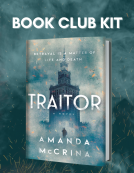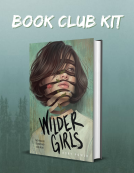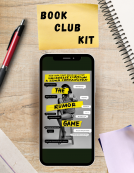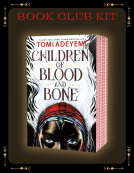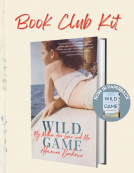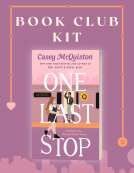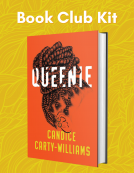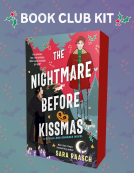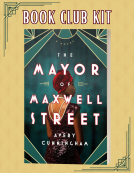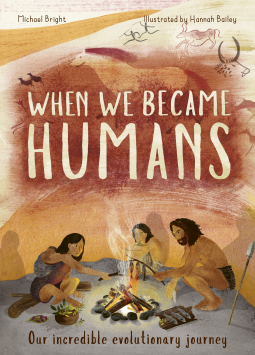
When We Became Humans
The Story of Our Evolution
by Michael Bright
This title was previously available on NetGalley and is now archived.
Send NetGalley books directly to your Kindle or Kindle app
1
To read on a Kindle or Kindle app, please add kindle@netgalley.com as an approved email address to receive files in your Amazon account. Click here for step-by-step instructions.
2
Also find your Kindle email address within your Amazon account, and enter it here.
Pub Date 16 Jul 2019 | Archive Date 8 Aug 2019
Quarto Publishing Group - words & pictures | words & pictures
Talking about this book? Use #WhenWeBecameHumans #NetGalley. More hashtag tips!
Description
This large-format, highly illustrated book guides readers through the key aspects of the human story, from the anatomical changes that allowed us to walk upright and increased brain size in our ancestors, to the social, cultural, and economic developments of our more recent cousins and our own species. Along the way, focus spreads take a closer look at some of the key species in our history, from the ancient Australopithecus Afarensis, 'Lucy', to our recent cousins the Neanderthals and ourselves, Homo sapiens.
Looking beyond the anatomical evolution of humans, this book explores how our culture and way of living has evolved, from how trails of cowry shells reveal early trade between tribes, to how and why humans first domesticated dogs, horses, and farm animals, and began settling in permanent villages and cities. Through digestible information and absorbing illustration, young readers will be given an insight into their own origins, and what it really means to be a human.
Available Editions
| EDITION | Other Format |
| ISBN | 9781786038876 |
| PRICE | US$22.99 (USD) |
| PAGES | 64 |
Average rating from 25 members
Featured Reviews
 Reviewer 531923
Reviewer 531923
This is the kind of book I would have enjoyed reading independently as a child. It starts with clarifying some terms which can be quite confusing for a young reader e.g. hominids, haplorhins and then goes to the very beginnings, the appearance of small primates. The book touches upon how scientists study fossils and discover all these fascinating facts. It also talks about walking upright, making first tools, fire control, cave art and the importance of climate change for our evolution. I loved the spreads on pre-historic food and healthcare development through time.
The book is amazingly comprehensive, including the burning question 'Is evolution over now that we can control our environment?'
Would make a great addition to a school library.
Thank you to NetGalley and Words and Pictures (Quarto Publishing group) for the ARc provided in exchange for an honest opinion.
 Bill C, Reviewer
Bill C, Reviewer
When We Became Humans: The Story of Our Evolution, by William Bright, is a nicely detailed and thorough overview of human evolution from our earliest primate ancestors through to Homo Sapiens. Following the arrival of our species, Bright continues the story by showing how human culture evolved through such developments as agriculture, art, and more.
This is one of those text-heavy books becoming more common in this golden age of children’s non-fiction. As such, and due as well to some of the vocabulary, it’s best read by older children, probably around ten at the earliest, though certainly parents could read it aloud and explain meanings to a younger child.
The early section on pre-hominids is clear and hits the highlights on differences as well as some theories of evolutionary development, such as the shift to bipedalism offering the survival benefit of seeing farther on the developing grasslands or color vision helping select ripened fruit. As one would expect of a modern book on the topic of human evolution, Bright highlights how the old “direct-line” theory has gone by the wayside, replaced by the more “bushy” version, with various hominid species living at the same time and even interbreeding, as he points out occurred between Home Sapiens and both Neanderthals and Denisovans.
As he notes physical changes, such as height, brain size, etc. Bright also points out various stages of cultural development, such as the taming of fire, the first tool use and how tools were later improved upon. As noted, he continues in this vein beyond the advent of Sapiens into domestication of animals, farming, shelter and clothing, and more. The end section briefly ponders whether or not humans are still evolving and if so, what that might look like. Finally, there’s a nice visual presentation of the chronology at the end.
The artwork is well done and does a nice job of conveying the information presented or going a bit beyond it, even if most of the illustrations are relatively small (I wouldn’t have minded a few pictures that has more space to work with).
Overall this is an excellent look at the topic for the age range, though a few quibbles. One is that there were several typos which I assume those will be fixed either before publication or in a second printing. The other is that sometimes it felt a few more modern views were glossed over. For instance, where agriculture began or the first big towns—there has been some questioning of older views on those that could have been covered. And finally, a few moments of narrative wonder might have added a lift here and there in terms of tone/style, such as describing the discovery of a particular hominid fossil rather than simply giving us the information. But really, these were quite small issues. Strongly recommended.
 Rebecca B, Educator
Rebecca B, Educator
This book is great a perfect introduction to human evolution for young children.
It packs in lots of information and is beautifully illustrated.
I shall be ordering several copies for the library,
 Elizabeth M, Reviewer
Elizabeth M, Reviewer
This looks really engaging for a young learner. I previewed it and am planning to read it with my homeschooled 6 year old. It’s so hard to find accurate, interesting, age-appropriate texts on this topic for young elementary kids, and this one looks like it’ll do really well.
 Katie B, Educator
Katie B, Educator
This book is a perfect introduction to the concept of human evolution. There is a lot of information on each time period, and some human ancestors that are not usually discussed in other books for children. The illustrations are very well done, and will definitely enhance the reading experience for children. In a homeschool setting, this will be an especially valuable resource. Secular homeschool families (those who homeschool for non-religious reasons) look for history books that discuss evolution and they are not always easy to find. This will be a wonderful addition to our prehistory studies with lots of information that will make a great jumping off point for further studies.
As an aside, as an adult, there was a lot of new and interesting information included. I found myself sharing this information with other adults who were equally as surprised. This makes a wonderful resource because parents/teachers can learn and be excited right along with their children/students.
 Pamela G, Librarian
Pamela G, Librarian
I received an electronic ARC from Quarto Publishing Group through NetGalley.
Well presented information on the the history of evolving humans. Bright takes middle grade readers through the centuries and explains the various skills that developed for survival. The illustrations support the text and help readers envision how the species looked.
Terrific STEM resource.
I have to admit, I was genuinely surprised at the level of information included in Michael Bright's<i> When We Became Humans</i>, which is illustrated by Hannah Bailey. I think, going in, I expected this book to be very introductory in terms of the evolution of humans, something meant to bring children into the beginning steps of what our beginnings and our journey actually looked like. What I got, however, was an incredibly thorough account of the transformation humans went through over the years. And it was impressive.
With that said, I do see this is a book that is more geared to the kids who are just moving into their teenage years. Children, anywhere between 10 years of age to 13 or 14, would be much more ideal readers for this book than I'd originally expected. I think it's great that this book provides such an amazing educational opportunity. A dense and enjoyable read, <i>When We Became Humans</i> does a fantastic job of detailing important facts about evolution and the experiences of humans from the past. Filled with exceptional illustrations and informative text, this is a great book to have on your shelf.
I'm really glad I had the chance to read it. And I think this book holds a lot of benefit for many, many others. It's the kind of book I'd love to see in a library. Even more, I'd love to see it in my own school. With the wealth of information it offers for children, it's well worth picking up for the kids that you know, even if they need to grow into it.
<i>I was provided a free copy of this book via NetGalley in exchange for an honest review.</i>
 John L, Reviewer
John L, Reviewer
A very good book, and one for strong consideration by any school librarian or home schooler. It looks at first like a pictorial book with bitty paragraphs dotted around the pages and spreads, but the writing is actually more engaging, and the text comes in fully-formed paragraphs as opposed to sentences and factoids. That way we really do get the chance to learn all I think we'd need to know about our ancestry – the early ape-like species and so on that form our family tree. But every aspect of life that might be known about to make a modern woman is here, too – what she ate, how she decorated her clothes, and when she moved into cities and gained specialised jobs, alongside the domestic animals and currencies that had had to start about the same time. It will often surprise you how far back all that happened – and there are of course the many known unknowns relating to our prehistory waiting for us to discover them. None of that takes away from the art, which doesn't need all the lurid colouring of some school books, and is all the better for it. Tutors will like as not need to give the class a crash course in negative numbering, counting backwards into the distant past and the scale this story plays out on, but after that the subject of anthropology is ready for any pupil. Wonderful.
It’s in our nature to want to know who we are and where we came from. When We Became Humans is a really great book all about us. Asking and answering questions about our beginnings, evolution and where we go from here. This book is absolutely filled with interesting information and colourful drawings.
 Media/Journalist 16509
Media/Journalist 16509
This is a very informative, well-illustrated book that goes into details about human evolution. At 64 pages, it is big enough to give an impressive amount of information while staying relatively easy to read. The text is large and presented in multiple blurbs on each spread, with lots of illustrations and maps. The facts are interesting and it covers a huge range of topics about how scientists know what they know, how humans evolved, moved, adapted and lived in all different ages, and even what the future looks like.
The one drawback is that it doesn't explain to kids how evolution really works. There are a lot of misconceptions about evolution and any good book on the subject really should have a basic lesson on what evolution does and doesn't mean.
That tiny note aside, this is a really well done book that would be especially great for homeschoolers and school libraries.
My rating system:
1 = hated it
2 = it was okay
3 = liked it
4 = really liked it
5 = love it, plan to purchase, and/or would buy it again if it was lost
I read a digital ARC of the book for the purpose of review.
 Han H, Educator
Han H, Educator
This is an expertly presented reference book that takes a look at the geographical and biological history of humans.
This is a perfect book to inspire and educate young ones.
 Kade G, Reviewer
Kade G, Reviewer
I received a copy of this book in exchange for my honest review. Thank you NetGalley!
awesome kids book.
we loved the illustrations.
the story was unique & easy to read!
 Joanne A, Educator
Joanne A, Educator
This book uses both graphics and description to explain how humans came in to being. It is set out in chapters which would enable specific topic study. The language is suitable for KS2 students, and is brought to life by the colourful illustrations throughout
 Sharon T, Reviewer
Sharon T, Reviewer
When We Became Humans: Our Incredible Evolutionary Journey, written by Michael Bright and illustrated by Hannah Bailey, is a children's nonfiction book. This large-format book guides readers through the key aspects of the human story, from the anatomical changes that allowed us to walk upright and increased brain size in our ancestors, to the social, cultural, and economic developments of our more recent cousins and our own species. Along the way, focus spreads take a closer look at some of the key species in our history, from the ancient Australopithecus Afarensis, 'Lucy', to our recent cousins the Neanderthals and ourselves, Homo sapiens.Looking beyond the anatomical evolution of humans, this book explores how our culture and way of living has evolved, from how trails of cowry shells reveal early trade between tribes, to how and why humans first domesticated dogs, horses, and farm animals, and began settling in permanent villages and cities. Through digestible information and absorbing illustration, young readers will be given an insight into their own origins, and what it really means to be a human.
When We Became Humans does a wonderful job of explaining and illustrating important anthropological and archaeological terms to readers. The information about the evolution of man is well chronicled here- with just about every aspect of out past and present understanding of it well covered. I found the text to be clear and well written, and the illustrations do a good job of adding detail and capturing the interest and imagination of readers. I thought I had a good understanding of the topic, but found this book to be extremely informative and accessible. I think that this is a book that readers will enjoy looking at on their own, and in an educational context. I really liked the included charts and text about science fiction or fact, and the thoughts about the future. It was well done all around.
When We Became Humans is a well organized and researched book that will appeal to interested readers and those reading for projects and
I requested this book with the how that I could read it together with my 8 year old daughter. Upon receiving the book, I decided to read it first myself and then selectively read it with her. Some of the scientific language will be above her level, but the content and information is really worth attempting to share it with her.
I learned a lot reading this book and really enjoyed it. For. A children’s scientific text, the few of information was really good and presenting in an interesting and attractive way. The illustrating were well done and added greatly to the text provided.
This is a great text detailing in chronological order the evolution of mankind, with is absolutly fascinating! This book has lit a fire in me and really inspired me to delve deeper into this topic. Great book.
When We Became Humans, Our incredible evolutionary journey by Michael Bright was released June 16, 2019.
I received a complimentary copy of this book from Quarto Publishing Group through NetGalley. Opinions expressed in this review are completely my own.
#WhenWeBecameHumans #NetGalley
 Kathleen G, Librarian
Kathleen G, Librarian
This book is a great introduction to human advancements from the beginning of humankind. In brief detail the book explains about how humans evolved, talking about Homo Erectus, Neanderthals, etc. This book touches on the introduction of farming, how humans used to hunt, and many other fascinating facts. This is a great middle grade book and my 3-5 graders will be fascinated.
This book is all about the beginning of man. Each double page spread details a different group of early people telling about their life and how they survived as well as how they differed from other groups. There are short pieces of text interspersed with warm, inviting art work. The kids and teachers at my Montessori school are going to love this one!
This is a wonderful book. Everyone should read it on coffee table or otherwise. As simple as that.
This book is about us and describes in a adorable way ; how we have changed over centuries.
Illustrations are wonderful and cohesive with printed story. Artwork makes book highly readable and enjoyable.
Captions are crisp, informative and interesting.
Human story starts from time when early pre human mammals started standing on feed and shifted eyes from side to front of the face.
Story of Neanderthal who became extinct due to modern humans is very interesting. So are various historical artifects surviving the test of time.
Every major details in our evolution is delineated with mesmerizing precision.
It is a book perfect for a gift to curious teenagers and intelligent grown ups.
At end it also underlines the fact that due to absence of natural predators we may be becoming weaker beings with smaller brains.
Thanks netgalley and publisher for review copy.
Readers who liked this book also liked:
We Are Bookish
Historical Fiction, Mystery & Thrillers, Teens & YA
We Are Bookish
Mystery & Thrillers, OwnVoices, Teens & YA
We Are Bookish
Multicultural Interest, OwnVoices, Teens & YA
We Are Bookish
Multicultural Interest, Mystery & Thrillers, Teens & YA
We Are Bookish
Sci Fi & Fantasy, Teens & YA
We Are Bookish
Biographies & Memoirs, Nonfiction (Adult), Parenting, Families, Relationships
We Are Bookish
Business, Leadership, Finance, Nonfiction (Adult), Self-Help
We Are Bookish
Literary Fiction, Multicultural Interest, Women's Fiction
We Are Bookish
LGBTQIA, Romance, Sci Fi & Fantasy
We Are Bookish
Historical Fiction, Literary Fiction, Multicultural Interest
We Are Bookish
Arts & Photography, Health, Mind & Body, OwnVoices
We Are Bookish
Biographies & Memoirs, Health, Mind & Body, Nonfiction (Adult)
We Are Bookish
General Fiction (Adult), Mystery & Thrillers
